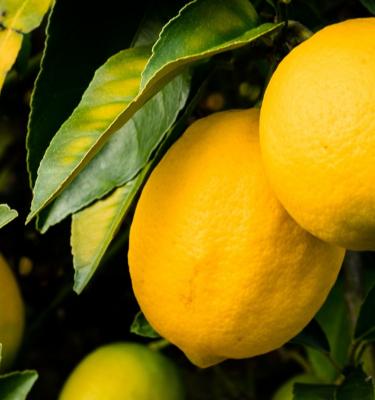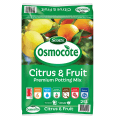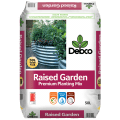

How to grow & care for lemon trees
Lemon trees are a classic backyard staple! These productive trees are long-lived and will grow in a large pot or in your garden. You can grow a lemon tree in most climates around Australia, except those with extremely heavy frosts. Look for a variety of grafted plants that are best suited to your climate.
Lemon trees need a full sun spot in moist but free-draining soil - if you have particularly heavy soils consider planting a lemon tree in a large pot instead or grow it in a raised garden bed.
Top 5 steps to growing lemon trees
- Choose a full sun spot with moist, free-draining soil or grow in a large pot
- Lemon trees do best in an area protected from strong winds
- Improve the soil before planting with Scotts Osmocote Compost Premium Soil Improver and Scotts Performance Natural All Purpose Organic Based Fertiliser
- Fertilise lemon trees with a specific citrus food like Scotts Osmocote Plus Organics Citrus & Fruit Plant Food & Soil Improver 2 times per year, before and after fruiting.
- Lemon trees need regular watering, especially when flowering and fruiting.
Shopping List
- A potted lemon tree
- Scotts Osmocote Compost Premium Soil Improver
- Scotts Osmocote Plus Organics Citrus & Fruit Plant Food & Soil Improver
- Garden shovel
- Mulch
- Defender Pyrethrium Insect Spray
- If growing in containers you’ll need,
- a large pot or planter
- Scotts Osmocote Citrus & Fruit Potting Mix
- a garden trowel
- mulch
Prepare
Lemon trees are best planted when the soil is warm in spring or summer if you live in a cooler climate, however, warmer regions can plant lemon trees year-round. Choose a full sun spot, with free-draining soil for your lemon tree.
Dig the hole twice as wide as the original pot or root ball and at the same depth. Loosen the original soil at the bottom of the planting hole and mix Scotts Osmocote Compost Premium Soil Improver and Scotts Osmocote Plus Organics Citrus & Fruit Plant Food & Soil Improver through the backfill soil and the soil at the base of the hole.
Planting in the garden
Remove the lemon tree from the nursery pot and position it in the prepared hole, at the same depth it was in the pot - if the tree is grafted, make sure the graft point sits well above the soil surface.
Mulch around the root zone of your lemon with an open organic mulch to retain moisture and suppress weeds. Lemon trees are very shallow rooted, so make sure the whole ‘drip zone’ of the area beneath the tree is mulched. Lemon trees generally do best, when they are not underplanted with anything.
Planting in pots
You can grow lemon trees in large pots or containers. Choose a lemon tree that has been grafted onto dwarfing rootstock or naturally has a smaller growth habit.
You’ll need a pot that’s at least 50cm deep by 50cm wide, with plenty of drainage holes. Fill the pot with Scotts Osmocote Citrus & Fruit Potting Mix - remove the lemon tree from the nursery pot and place it in the centre of the pot, backfill around the root ball and water it in well.
Apply an open organic mulch over the surface of the potting mix to retain moisture and suppress weeds.
Fertilising & General Care
Feed your lemon tree every 6 months (generally in spring and again in autumn) with Scotts Osmocote Plus Organics Citrus & Fruit Plant Food & Soil Improver at the recommended rate. Potted lemon trees may also benefit from an extra boost of nutrients with Scotts Osmocote Pour+Feed for Flowering Plants just before they begin to set flowers.
Prune to shape after your lemon tree has finished fruiting. Ideally, your lemon tree should be an upside-down teardrop shape with an open, airy centre that’s not overly crowded with branches. Tip pruning each year will avoid the need for drastic pruning.
Keep the height of your lemon tree under 2 metres to make harvesting the fruit or netting the tree easier.
Pests, Diseases & other Problems
Lemon trees can be prone to several pests and diseases. If your lemon tree is showing signs of nutrient deficiency - yellowing leaves or the veins of the leaves are green, but the rest of the leaf is yellow - apply Scotts Osmocote Pour+Feed for Flowering Plants or Scotts Osmocote Plus Organics Citrus & Fruit Plant Food & Soil Improver at the recommended rate. If this does not correct the yellowing leaves, consider a soil pH test kit and correct the soil if needed before reapplying fertiliser. Lemon trees prefer soil with a pH of around 6.0-7.5.
Insect pests that can infest lemon trees include; gall wasps, citrus leaf miners, aphids and scale. To control outbreaks of aphids or scale, apply Defender Pyrethrium Insect Spray as per the labels instructions.
Watch for Queensland Fruit Fly infestations with monitor traps and by regularly cutting into your fruit to check for maggots. If you find fruit flies, use bait and wildlife-safe insect exclusion netting to protect your lemon crop from further attack. Always pick up any fruit that falls to the ground and dispose of it.



